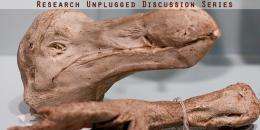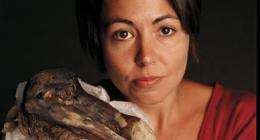Where have all the dodos gone?

Biology professor Beth Shapiro is one part laboratory scientist and one part Indiana Jones style adventurer, traveling to remote locations to find fossilized bones and eggshells of ancient animals and extract their ancient DNA for clues to their prehistoric past.
During the final Research Unplugged conversation of spring semester, Shapiro shared tales of her explorations in and out of the lab, and led a discussion on the role of humans and the climate in the mass extinction of several ancient species.
She offered the audience a detailed description of her fossil-finding expeditions in eastern Siberia, the modern day location of Beringia, the ancient land bridge that connected Russia to Alaska when sea levels dropped during the last Ice Age.
She also recounted a nerve-racking flight aboard a Russian helicopter, a challenging canoe trip, and a campsite surrounded by hordes of mosquitos.
The bones Shapiro and her colleagues collected enabled them to map out the lifespans of six megafauna herbivores and evaluate how their populations reacted to the arrival of humans and the change in temperature.
Q & A with Beth Shapiro
Shaffer Career Development Assistant Professor, Department of Biology
You have some background in broadcast journalism. Would you say that experience has proven unexpectedly helpful for your current position as a molecular biologist?
While I was in high school and an undergrad I worked as a reporter for both television and radio news, and was absolutely certain that broadcast journalism was the career choice for me. During the summer after my freshman year at the University of Georgia, I took a class offered by the Honors program that changed my mind. It was a geology and anthropology course, and it was held outside: nine weeks of traveling (in both directions) across the width of the country, sleeping each night in different national parks. I realized then that what I really wanted to do was science journalism. Along the way, I seem to have ended up being a scientist instead. My experience in broadcast journalism has no doubt helped me as a scientist, by teaching me both how to pitch stories and ideas to colleagues and scientific journals, and how to communicate clearly the excitement of new discoveries—both my own and those of my colleagues—to the public and the popular press. Too much great science gets lost or is undervalued simply because telling a story is tough to do, particularly when you're talking about enzymes and DNA and other things that a non-scientist doesn't run across every day. I think it's my and other scientists’ responsibility to do a better job in this regard.
Of the different awards and accolades you’ve been honored with throughout your career, which one surprised you the most to receive?
Definitely the MacArthur Fellowship. Aside from being a tremendous honor that I still don't feel I deserve, they actually tricked me a little bit, adding to the surprise. I was very pregnant—nearly 8 months along—when I got a rather demanding email from a prospective student. This student was only going to be in town for one day and really wanted to meet with me during her visit. Unfortunately, the only time she was available was at 8:00 in the morning, which was not easy for me to make in my challenged physical state. As I waddled uncomfortably through town to campus, I became more and more certain that agreeing to meet this student was a very bad idea. When I arrived on time, and she did not, I was pretty upset. About an hour later, I got a phone call from the MacArthur Foundation, telling me that I'd been selected for the Fellowship. Needless to say, after my disbelief faded, so did my anger. I was elated! Not to mention completely surprised. A few hours later, as I was writing back to the student to rearrange our meeting I got another call from the foundation. They had forgotten to tell me that morning that I should not expect the visit from the prospective student: They had made her up. They just wanted to be sure I'd be in my office when they called, and had used her as an excuse to get me there.
Which has been your favorite research project so far?

I love working in the field, particularly in the Arctic. There is something about the landscape of the far north that I find both inspiring and invigorating (and I doubt it is the millions of mosquitoes). Therefore, my favorite research projects are those that give me an excuse to get out into the field, looking for bones to grind up and hopefully extract DNA from. Most of my work in the Arctic has focused on understanding the megafaunal mass extinction event that happened across the globe between about 50,000 and 8,000 years ago. Using the DNA sequences, we trace populations of large mammals such as bison, horses, caribou, mammoth, and woolly rhino through time and over space. We detect periods of population growth or decline; or of rapid movements across the landscape or between continents. We can then correlate these genetic changes to particular environmental events, such as the peak of the last ice age or the first appearance of humans in North America, and then ask questions about how and when some species went extinct, or why other species survived. The results of this work have implications for understanding how species today will respond to current climate change.
What has been the biggest change or development in your field over the years?
Despite its name, the scientific field of “ancient DNA” is actually very young. The first DNA sequences isolated from the remains of a dead organism were published in 1984. They were from a museum-preserved specimen of the extinct quagga, a relative of the zebra. Although the idea that DNA was preserved in organisms after death was tremendously exciting, the field really did not take off until a few years later. This was due to the invention and widespread adoption of the polymerase chain reaction, a technique that makes it possible to isolate the few remaining DNA molecules in a specimen and make many millions of synthetic copies, which can be used to learn the exact sequence of that piece of DNA. Even more recently, tremendous advances in DNA sequencing technologies (often called “next-generation sequencing”) have once again revolutionized ancient DNA: we can now look at entire genomes of extinct organisms, rather than limit our questions to those answerable using only small fragments of DNA. We're just now on the brink of this major change, and I expect to see significant developments in ancient DNA within the next few years.
What is the biggest misconception about your field of research?
We cannot isolate ancient DNA from dinosaurs. The oldest authenticated ancient DNA sequences are in the realm of 300,000 years, and these are from frozen environments in the high Arctic where conditions are ideal for the long-term preservation of biological material. There is some evidence that DNA might be preserved, in exceptional circumstances, for up to around 1 million years. Dinosaurs, however, have been extinct for more than 50 million years. We do not get DNA out of fossilized bone (these are rocks!). Perhaps someday someone will discover a dinosaur buried in such a way that the bones will not have become rock... but I tend to doubt it.
What direction do you see your field going in the future?
Because ancient DNA studies have been limited to mostly analyzing small fragments of DNA, the range of scientific questions that could be addressed using this technique has been relatively limited. DNA isolated from single individuals of extinct species has been used to figure out what living species the extinct species are most closely related to. DNA isolated from large numbers of individuals of the same species has been used to estimate the size of ancient populations and ask whether (and when) these populations began to decline. Until recently, however, it has been very difficult to target genetic information that relates to phenotype (how an animal looks or behaves): the very characteristics upon which natural selection acts. With improved DNA extraction techniques and the introduction of next-generation sequencing technologies, these questions are no longer out of our reach. I expect that in the next few years ancient DNA experiments will more and more frequently work at the genome scale. This work will no doubt allow huge advances in understanding how species, including our own, evolve through time.
Provided by Pennsylvania State University



















